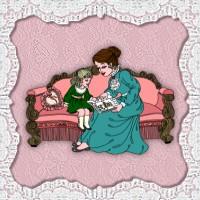 Don't you just love this quote from Dr. Seuss:
Don't you just love this quote from Dr. Seuss:The more that you read,
the more things you will know.
The more that you learn,
the more places you'll go.
~ Dr. Seuss ~
A verse so simple yet so very true. Children learn to read from their parents or as Emilie Buchwald said in 1994, "Children are made readers on the laps of their parents." So, it is vitally important for parents to read to their children from infancy. The more children read, the better they become at reading. And, the more young children are read to, the greater their interest in reading. Reading out loud to children helps them with their verbal skills, enhances their development and teaches them how to express themselves verbally.
Other people have also stated this so eloquently:
Books, to the reading child, are so much more than books -- they
are dreams and knowledge, they are a future, and a past.(1940)
~ Esther Meynell ~
There is no substitute for books in the life of a child. (1952)
~ Mary Ellen Chase ~
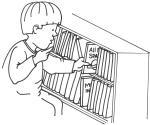 It is not enough to simply teach children to read;
It is not enough to simply teach children to read;we have to give them something worth reading.
Something that will stretch their imaginations-
something that will help them make sense of their own
lives and encourage them to reach out toward people
whose lives are quite different from their own.
~ Katherine Paterson ~
 If you've been a reader of my Linda's Blog you know that I've had a long term love affair with dolls, doll patterns, the Victorian era, floral design, and genealogy. You also know that I love research and history. What you don't know until now is that I have always LOVED books and reading, too. As far as I'm concerned you can never have enough dolls and you can never have enough books.
If you've been a reader of my Linda's Blog you know that I've had a long term love affair with dolls, doll patterns, the Victorian era, floral design, and genealogy. You also know that I love research and history. What you don't know until now is that I have always LOVED books and reading, too. As far as I'm concerned you can never have enough dolls and you can never have enough books.My house is filled with them. Books of all kinds. My love affair with books began very early on. My Mother is an avid reader, my Father was an avid reader, my Grandmother and Great-Aunt were avid readers, and so it was passed down to my siblings and I.
I can remember sitting in my Grandmother's rocking chair (which I still have) and having her read me a story. Sometimes we would sit there while she was watching her soap opera's and then she would read me my story. I never minded just sitting there with her. I always knew there would be a story. And, I always felt safe in her arms.

Now, when I read I think about sitting with my Grandmother or listening to my Mom and Dad talk about their love of reading and it brings back warm and pleasant feelings for me.
Reading is such an escape. You can literally get lost in a book. The book for a brief moment becomes your life and you can imagine that you're experiencing it. There is nothing more powerful then your imagination. Even the most spectacular movie with all its wonderful special effects and cinematography cannot compare to what you own imagination can create. There are no limits, no boundaries to your imagination when you are reading. Reading can take you anywhere. If you know how to read you can do anything because there isn't anything you can't do if you put your mind to it.
I am a firm believer in books and reading as a way of teaching children. And it must be taught at a very young age, on the laps of our parents, as the graphic above nicely conveys. As Mccosh quoted, "The book to read is not the one which thinks for you, but the one which makes you think."
In fact, my Grandchildren can attest to the fact that every Christmas or Birthday they know what at least one of their presents will be from their Grandmother: books. To me, that is one of the best presents I could give them. By giving them books all the time, I hope somehow I'm conveying a love of reading to them. Reinforcing the value of reading time and time again. Making them think. Hopefully, by developing good reading skills they learn how to think for themselves.
For I firmly believe in the following quote:
To read is to empower
To empower is to write
To write is to influence
To Influence is to change
To change is to live.
~ Jane Evershed ~
More than a Tea Party
 In fact, I was watching a show on one of the cable channels about the greatest invention mankind has ever seen. They counted down through hundreds of inventions until they got to #1. Do you know what it was? The greatest invention mankind has ever seen was the invention of the printing press. Why, because it opened the whole world up to everyone and mankind was never the same again.
In fact, I was watching a show on one of the cable channels about the greatest invention mankind has ever seen. They counted down through hundreds of inventions until they got to #1. Do you know what it was? The greatest invention mankind has ever seen was the invention of the printing press. Why, because it opened the whole world up to everyone and mankind was never the same again.So, grab a book. Take it to a quiet place and get lost in your own imagination. And the next time your Grandchildren come to visit spend the weekend reading to them, not watching T.V. or playing video games. Just reading from books. Your Grandchildren may surprise you and love it. And, you will open up a magical world to them from which they will never return.
I did it!
Come and look
At what I've done!
I read a book!
When someone wrote it
Long ago
For me to read,
How did he know
That this was the book
I'd take from the shelf
And lie on the floor
And read by myself?
I really read it!
Just like that!
Word by word,
From first to last!
I'm sleeping with
This book in bed,
This first FIRST book
I've ever read!
~ David L. Harrison ~
(from Somebody Catch My Homework)

 "What do you want to do?" "I don't know. What do you want to do?" "Hey, I know. Let's play dress-up." "Yeah! Let's play dress-up." "I'll be mommy." "No, I want to be mommy." "Mom, Linda won't let me be you." "Linda, let your sister be me."
"What do you want to do?" "I don't know. What do you want to do?" "Hey, I know. Let's play dress-up." "Yeah! Let's play dress-up." "I'll be mommy." "No, I want to be mommy." "Mom, Linda won't let me be you." "Linda, let your sister be me."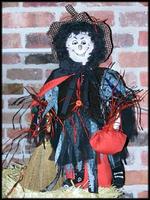 Well there's only 20 days to go until Halloween, or what's formerly known as "All Hallows Eve." Halloween has also become a favorite of doll makers and crafters because there are so many different types of dolls, doll patterns and crafts that you can make for this one holiday. Ghosts, goblins, and witches.
Well there's only 20 days to go until Halloween, or what's formerly known as "All Hallows Eve." Halloween has also become a favorite of doll makers and crafters because there are so many different types of dolls, doll patterns and crafts that you can make for this one holiday. Ghosts, goblins, and witches. 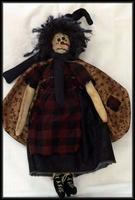 But, where did this and why did this all start? The answer lies in the true origins of Halloween and the ancient Celtic tribes who lived in Ireland, Scotland, Wales and Brittany. November 1st for the Celts marked the beginning of a new year and the coming of winter. So the night before the new year the Celts celebrated the Festival of Samhain, who was the Lord of the Dead. The Celts believed that during this festival the souls of the dead (including ghosts, goblins, and witches,
But, where did this and why did this all start? The answer lies in the true origins of Halloween and the ancient Celtic tribes who lived in Ireland, Scotland, Wales and Brittany. November 1st for the Celts marked the beginning of a new year and the coming of winter. So the night before the new year the Celts celebrated the Festival of Samhain, who was the Lord of the Dead. The Celts believed that during this festival the souls of the dead (including ghosts, goblins, and witches,  In order to scare away the evil spirits the Celts would wear masks and the children would wear costumes. Halloween costumes have traditionally been monsters such as vampires, ghosts, witches, and devils,
In order to scare away the evil spirits the Celts would wear masks and the children would wear costumes. Halloween costumes have traditionally been monsters such as vampires, ghosts, witches, and devils, But, why are they called jack-o-lanterns? It all started with an Irishman (of course) named Jack who was forced to roam the earth with just a burning coal inside his pumpkin to light the way for him. He had to roam the earth forever because he had never performed a single selfless act his whole life,
But, why are they called jack-o-lanterns? It all started with an Irishman (of course) named Jack who was forced to roam the earth with just a burning coal inside his pumpkin to light the way for him. He had to roam the earth forever because he had never performed a single selfless act his whole life,  You can't be a doll designer or doll pattern designer and not have one, two, three, four or more scarecrow dolls. They can be primitive, classic, scary, well-dressed, tattered, large or small bodied, cheerful, scary, etc. It doesn't matter. They're a staple of every crafter. Why is that? Why are we so enthralled with them? I'm not sure, but I'd like to find out.
You can't be a doll designer or doll pattern designer and not have one, two, three, four or more scarecrow dolls. They can be primitive, classic, scary, well-dressed, tattered, large or small bodied, cheerful, scary, etc. It doesn't matter. They're a staple of every crafter. Why is that? Why are we so enthralled with them? I'm not sure, but I'd like to find out. While they have traditionally been known as scarecrows they have had several names and have taken on several forms. In Pennsylvania the German farmers built human looking scarecrows called "bootzamon" or bogeyman. The "Bootzamon's" body was a wooden cross and his head was a broom, mop top, or piece of cloth stuffed with straw. He usually wore old overalls, shirt, straw hat, and red handkerchief around his neck. Sometimes more than one was built (everybody needs a little company, even scarecrows). The German farmers even had a "bootzafrau" or bogeywife. After all, every scarecrow needs a partner, don't they? The "bootzafrau" was usually dressed in a long dress or coat, wearing a hat or sunbonnet, and was placed in the opposite end of the field. So, you had a "bootzamon" on one end and a "bootzafrau" on the other end. Wonder which one really wore the pants in that family!
While they have traditionally been known as scarecrows they have had several names and have taken on several forms. In Pennsylvania the German farmers built human looking scarecrows called "bootzamon" or bogeyman. The "Bootzamon's" body was a wooden cross and his head was a broom, mop top, or piece of cloth stuffed with straw. He usually wore old overalls, shirt, straw hat, and red handkerchief around his neck. Sometimes more than one was built (everybody needs a little company, even scarecrows). The German farmers even had a "bootzafrau" or bogeywife. After all, every scarecrow needs a partner, don't they? The "bootzafrau" was usually dressed in a long dress or coat, wearing a hat or sunbonnet, and was placed in the opposite end of the field. So, you had a "bootzamon" on one end and a "bootzafrau" on the other end. Wonder which one really wore the pants in that family!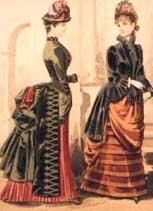 I have to wonder sometimes why I have such a fascination or passion for the fashions of the Victorian Era when I am clearly a feminist (the ultimate feminist according to my son-in-law).
I have to wonder sometimes why I have such a fascination or passion for the fashions of the Victorian Era when I am clearly a feminist (the ultimate feminist according to my son-in-law).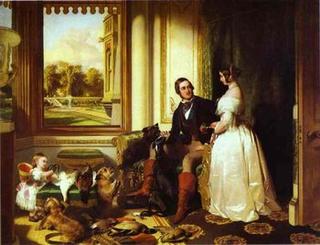 If you're been reading my
If you're been reading my